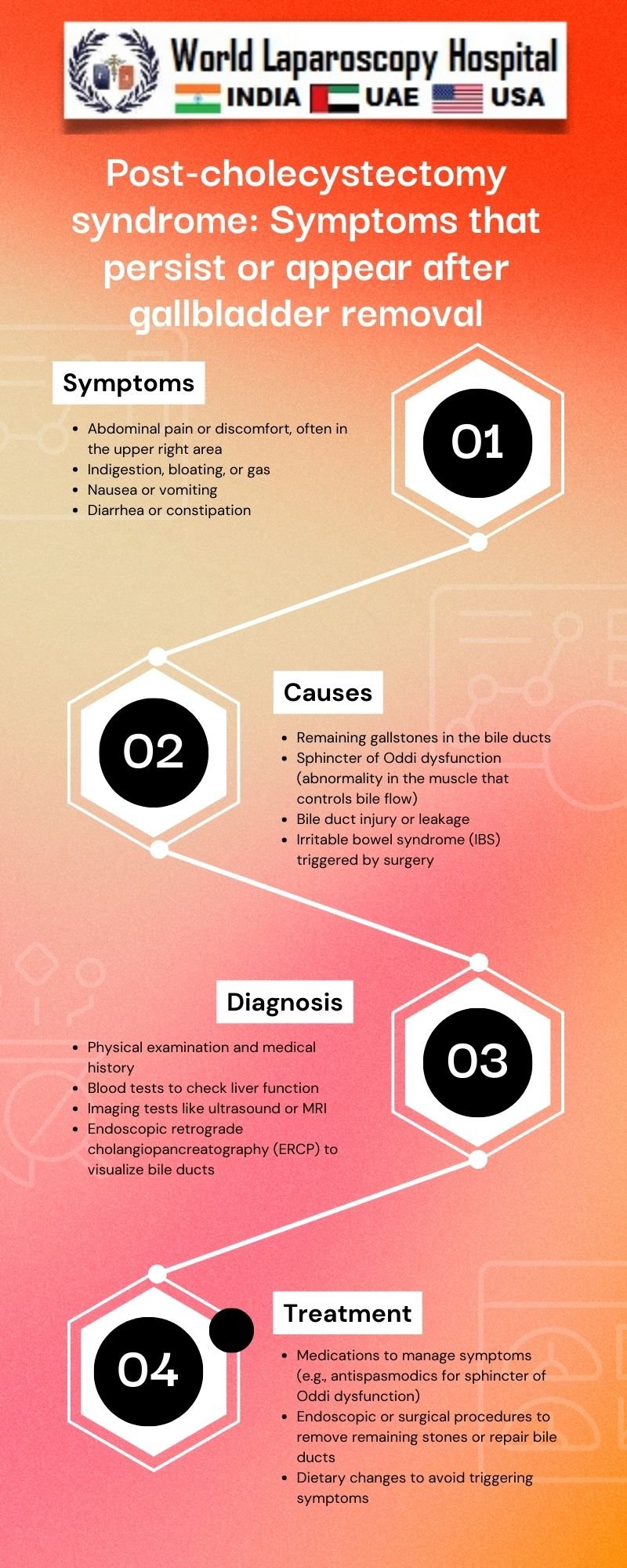Post-cholecystectomy syndrome: Symptoms that persist or appear after gallbladder removal
Introduction:
Cholecystectomy, or the surgical removal of the gallbladder, is a common procedure performed to treat gallbladder-related conditions such as gallstones. While most patients experience relief from symptoms after surgery, some individuals develop a condition known as post-cholecystectomy syndrome (PCS). PCS refers to the presence of symptoms that persist or develop after gallbladder removal. This article explores the symptoms, causes, diagnosis, and management of PCS.

Symptoms of Post-Cholecystectomy Syndrome:
PCS can manifest in various ways, and the symptoms may vary from person to person. Common symptoms include:
Abdominal pain:
Persistent or recurrent pain in the upper abdomen is a hallmark symptom of PCS. The pain may be dull, sharp, or cramp-like and may occur after meals or at night.
Indigestion:
Some individuals experience ongoing indigestion, bloating, or discomfort after eating, especially fatty or greasy foods.
Diarrhea:
Chronic diarrhea is another common symptom of PCS, which may be watery or accompanied by urgency.
Nausea and vomiting:
Some patients may experience persistent nausea or episodes of vomiting after cholecystectomy.
Jaundice:
In rare cases, PCS can lead to jaundice, a condition characterized by yellowing of the skin and eyes.
Causes of Post-Cholecystectomy Syndrome:
The exact cause of PCS is not always clear, but several factors may contribute to its development:
Residual or recurrent gallstones:
In some cases, gallstones may remain in the bile ducts or form anew after cholecystectomy, leading to symptoms.
Sphincter of Oddi dysfunction:
Dysfunction of the sphincter of Oddi, a muscular valve that controls the flow of bile and pancreatic juices into the small intestine, can cause abdominal pain and other symptoms.
Bile duct injury or strictures:
Surgical injury to the bile ducts during cholecystectomy or the formation of strictures (narrowing) can lead to bile flow obstruction and symptoms of PCS.
Altered bile composition:
Changes in the composition of bile after gallbladder removal may contribute to symptoms such as diarrhea and indigestion.
Other gastrointestinal disorders:
Some patients may have underlying gastrointestinal disorders, such as irritable bowel syndrome (IBS) or functional dyspepsia, which can cause symptoms similar to PCS.
Diagnosis of Post-Cholecystectomy Syndrome:
Diagnosing PCS can be challenging, as the symptoms overlap with many other gastrointestinal disorders. A thorough medical history, physical examination, and various tests may be needed to rule out other conditions and confirm the diagnosis. These tests may include:
Blood tests:
Blood tests can help assess liver function and rule out other conditions that may cause similar symptoms.
Imaging studies:
Ultrasound, CT scan, or MRI may be used to evaluate the bile ducts and rule out residual or recurrent gallstones.
Endoscopic retrograde cholangiopancreatography (ERCP):
RCP is a procedure that allows the visualization of the bile ducts and can help diagnose strictures or other abnormalities.
Sphincter of Oddi manometry:
This test measures the pressure in the sphincter of Oddi and can help diagnose sphincter of Oddi dysfunction.
Management of Post-Cholecystectomy Syndrome:
The management of PCS depends on the underlying cause and the severity of symptoms. Treatment options may include:
Medications:
Antispasmodic medications, bile acid sequestrants, and other medications may be prescribed to help manage symptoms such as abdominal pain, diarrhea, and indigestion.
Endoscopic or surgical interventions:
In cases where there is evidence of bile duct stones or strictures, endoscopic procedures such as ERCP with sphincterotomy or stent placement may be performed to improve bile flow.
Lifestyle modifications:
Dietary changes, such as avoiding fatty or spicy foods, and eating smaller, more frequent meals, may help reduce symptoms.
Psychological support:
Some patients may benefit from counseling or therapy to cope with the physical and emotional challenges of PCS.
Follow-up care:
Regular follow-up with a healthcare provider is important to monitor symptoms and adjust treatment as needed.
Conclusion:
Post-cholecystectomy syndrome is a complex condition that can cause persistent or recurrent symptoms after gallbladder removal. While the exact cause of PCS is not always clear, various factors such as residual gallstones, sphincter of Oddi dysfunction, and bile duct injury may contribute to its development. Diagnosis of PCS requires a thorough evaluation, and treatment may involve medications, endoscopic interventions, lifestyle modifications, and psychological support. By understanding the symptoms, causes, and management of PCS, healthcare providers can provide better care for patients experiencing this challenging condition.
| Older Post | Home | Newer Post |





